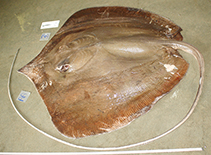http://www.fishbase.org/Summary/speciesSummary.php?genusname=Himantura&speciesname=uarnacoides ---> http://192.134.151.83/Summary/speciesSummary.php?genusname=Himantura&speciesname=uarnacoides
http://192.134.151.83/Summary/speciesSummary.php?genusname=Himantura&speciesname=uarnacoides ---> https://fishbase.mnhn.fr/Summary/speciesSummary.php?genusname=Himantura&speciesname=uarnacoides
https://fishbase.mnhn.fr/Summary/speciesSummary.php?genusname=Himantura&speciesname=uarnacoides ---> https://fishbase.mnhn.fr/summary/Himantura-uarnacoides.html
Pateobatis uarnacoides, Whitenose whipray

You can
sponsor
this page
Common name (e.g. trout)
Genus + Species (e.g. Gadus morhua)
-

-
About this page
-
Languages
-
User feedbacks
-
Citation
-
Uploads
-
Related species
-


 Whitenose whipray
Add your observation in
Fish Watcher
Upload your
photos
and
videos
Whitenose whipray
Add your observation in
Fish Watcher
Upload your
photos
and
videos
Pictures
|
Google image
 Pateobatis uarnacoides
Pateobatis uarnacoides
Picture by
Krajangdara, T.
Elasmobranchii (sharks and rays) >
Myliobatiformes
(Stingrays) >
Dasyatidae
(Stingrays) > Urogymninae
Etymology:
Pateobatis:
Combination of Latin 'pateo' for 'lie open, be exposed' and 'batis' for skate, ray or flatfish; referring to the eclectic nature of members of this group.
.
More on author:
Bleeker
.
Environment: milieu / climate zone / depth range / distribution range
Ecology
Marine; demersal; depth range ? - 30 m (Ref.
58048
). Tropical
Indo-Malay Arch., Java to Vietnam, including Sumatra and Borneo.
Length at first maturity / Size / Weight / Age
Maturity: L
m
?
, range 75 - ? cm
Max length : 119 cm WD male/unsexed; (Ref.
58048
)
Demersal on soft substrates to a depth of at least 30 m (Ref.58048). Ovoviviparous (Ref.
50449
). Common catch component of the demersal tangle net and bottom trawl fisheries. Utilized for its meat, skin (high value) and cartilage (Ref.58048).
Life cycle and mating behavior
Maturity
|
Reproduction
|
Spawning
|
Eggs
|
Fecundity
|
Larvae
Exhibit ovoviparity (aplacental viviparity), with embryos feeding initially on yolk, then receiving additional nourishment from the mother by indirect absorption of uterine fluid enriched with mucus, fat or protein through specialised structures (Ref.
50449
). Distinct pairing with embrace (Ref.
205
). Distinct pairing with embrace (Ref.
205
).
Compagno, L.J.V.
, 1999. Checklist of living elasmobranchs. p. 471-498. In W.C. Hamlett (ed.) Sharks, skates, and rays: the biology of elasmobranch fishes. Johns Hopkins University Press, Maryland. (Ref.
35766
)
IUCN Red List Status (Ref.
130435
)
Endangered (EN)
(A2d); Date assessed:
13 May 2020
CITES
Not Evaluated
Not Evaluated
Threat to humans
Harmless
Human uses
FAO - Publication:
search
|
FishSource
|
More information
Countries
FAO areas
Ecosystems
Occurrences
Introductions
Stocks
Ecology
Diet
Food items
Food consumption
Ration
Common names
Synonyms
Metabolism
Predators
Ecotoxicology
Reproduction
Maturity
Spawning
Spawning aggregation
Fecundity
Eggs
Egg development
Age/Size
Growth
Length-weight
Length-length
Length-frequencies
Morphometrics
Morphology
Larvae
Larval dynamics
Recruitment
Abundance
BRUVS
References
Aquaculture
Aquaculture profile
Strains
Genetics
Electrophoreses
Heritability
Diseases
Processing
Nutrients
Mass conversion
Collaborators
Pictures
Stamps, Coins Misc.
Sounds
Ciguatera
Speed
Swim. type
Gill area
Otoliths
Brains
Vision
Tools
E-book
|
Field guide
|
Identification keys
|
Length-frequency wizard
|
Life-history tool
|
Point map
|
Classification Tree
|
Catch-MSY
|
Special reports
Check for Aquarium maintenance
|
Check for Species Fact Sheets
|
Check for Aquaculture Fact Sheets
Download XML
Summary page
|
Point data
|
Common names
|
Photos
Internet sources
AFORO (otoliths) |
Aquatic Commons
|
BHL
|
Cloffa
|
BOLDSystems
|
Websites from users
|
Check FishWatcher
|
CISTI
|
Catalog of Fishes
:
genus
,
species
|
DiscoverLife
|
ECOTOX
| FAO - Publication:
search
|
Faunafri
| Fishipedia |
Fishtrace
| GenBank:
genome
,
nucleotide
|
GloBI
|
Google Books
|
Google Scholar
|
Google
| IGFA World Record |
MitoFish
|
Otolith Atlas of Taiwan Fishes
|
PubMed
| Reef Life Survey | Socotra Atlas |
Tree of Life
| Wikipedia:
Go
,
Search
| World Records Freshwater Fishing |
Zoological Record
Estimates based on models
Preferred temperature (Ref.
123201
): 28.7 - 29.2, mean 29 °C (based on 421 cells).
Phylogenetic diversity index (Ref.
82804
): PD
50
= 0.5312 [Uniqueness, from 0.5 = low to 2.0 = high].
Bayesian length-weight: a=0.00832 (0.00366 - 0.01891), b=3.10 (2.90 - 3.30), in cm total length, based on LWR estimates for this (Sub)family-body shape (Ref.
93245
).
Trophic level (Ref.
69278
): 3.5 ±0.5 se; based on size and trophs of closest relatives
Resilience (Ref.
120179
): Low, minimum population doubling time 4.5 - 14 years (Assuming fecundity<100).
Fishing Vulnerability (Ref.
59153
): Very high vulnerability (90 of 100).
Back to Search
Random Species
Back to Top
Accessed through:
Not available
FishBase mirror site :
localhost
Page last modified by :
mrius-barile
- 20 July 2016
Fatal error
: Uncaught ArgumentCountError: Too few arguments to function checkEcotox(), 1 passed in /var/www/html/summary/speciessummary.php on line 2304 and exactly 3 expected in /var/www/html/includes/speciessummary.lib.php:2579 Stack trace: #0 /var/www/html/summary/speciessummary.php(2304): checkEcotox() #1 {main} thrown in
/var/www/html/includes/speciessummary.lib.php
on line
2579
|